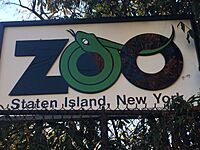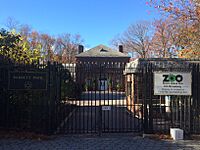Staten Island Zoo facts for kids

Staten Island Logo
|
|

Staten Island Zoo Entrance
|
|
| Date opened | June 10, 1936 |
|---|---|
| Location | 614 Broadway, Staten Island |
| Land area | 8 acres (3.2 ha) |
| Coordinates | 40°37′30″N 74°06′54″W / 40.625°N 74.115°W |
| No. of animals | 1400 |
| No. of species | 320 |
| Memberships | Association of Zoos and Aquariums (AZA) |
| Major exhibits | Africa, Tropical Forest, Reptile Wing |
The Staten Island Zoo is a fun 8-acre (3.2 ha) zoo in West New Brighton, Staten Island, New York City. It's a great place to visit all year round! The only days it closes are Thanksgiving, Christmas, and New Year's Day. Since 1988, the zoo has been approved by the Association of Zoos and Aquariums (AZA). This means it meets high standards for animal care and education.
Contents
Discovering the Staten Island Zoo's History
The Staten Island Zoo, also known as Barrett Park, has an interesting past. It started thanks to three important people from Staten Island: Colonel Edward Harden, Colonel Richard Penn Smith, and Major Clarence Barrett. In the 1800s, many military leaders lived on Staten Island.
How the Zoo Land Was Chosen
The zoo was built on what used to be Colonel Edward Harden's large property. Colonel Harden fought in the Spanish–American War. He moved to 614 Broadway on Staten Island in 1908 with his wife, Julia Harden. They lived in a house later called the "Harden Mansion."
When Julia Harden passed away in 1930, she left the land to New York City. She had three special requests. First, the park had to be named after her brother-in-law, Civil War Major Clarence Barrett. Second, the property could not be used as a playground. Third, her husband, Colonel Harden, could continue living in their house.
The city officially called the site "Barret Park." It wasn't until the 1960s that people started calling it the "Staten Island Zoo." For many years, the signs only mentioned "Zoological" as part of the "Staten Island Zoological Society." This group helped run the park.
Building the Zoo: A Community Effort
In August 1933, the Staten Island Zoological Society was formed. The park itself was built by the Civilian Conservation Corps. This was a program that helped people find work during tough economic times.
In 1935, a special bill was passed to help the city pay for the zoo's upkeep. The Governor of New York also agreed to provide public money for the zoo's daily costs. The Staten Island Zoological Society was in charge of the animal exhibits, care, and educational programs.
With the land owned by the city and a society to run it, construction began in 1933. The goal was to turn the 8-acre estate into a zoo. The Staten Island Zoo officially opened its doors to the public on June 10, 1936. It was known as the first "educational zoo" in the United States.
Notable People and Early Success
From 1942 to 1966, Patricia O'Connor was the main animal caretaker. She was known as the only woman veterinarian working in any zoo in the country at that time.
By 1949, the zoo had over 1,200 animals and a 400-seat auditorium. About 500,000 visitors came each year! The zoo was praised for being "spotless, modern, and odorless."
The Zoo's Parking Lot History
The zoo's parking lot was built in 1968. It is located across from the zoo on the corner of Clove Road and Martling Avenue. This land was once the home of Colonel Richard Penn Smith, a Civil War hero. He fought in the Battle of Gettysburg and is buried in Staten Island.
His large home and land were later bought by the Actors Fund. They turned the house into a peaceful retreat for actors. Later, the retreat closed. The land was then divided between the Staten Island Zoological Society for the parking lot and Saint Peter's Cemetery for more burial sites.
A Step Towards Safer Gasoline
In 1971, some animals at the zoo became sick from lead poisoning. A black leopard named Mr. Leo Pard suffered nerve damage. It was discovered that the lead came from an additive in gasoline. This sad event helped lead to the removal and ban of leaded gasoline in the United States. This made the air much cleaner for everyone.
The Staten Island Zoological Society: Education First
Unlike other zoos in New York City, which are run by the Wildlife Conservation Society (WCS), the Staten Island Zoo is managed by the Staten Island Zoological Society. This society was started in August 1933 by Harold O'Connel.
Some people say the society partly grew from a local reptile club. This might explain why the zoo has always been famous for its large collection of reptiles. The Staten Island Zoological Society officially became a non-profit organization on July 24, 1934.
Zoo's Focus on Learning
The Staten Island Zoological Society created the zoo with a main goal: to be an educational zoo. They held monthly evening talks at the zoo and taught lessons at local schools. They also gave tours for school children.
Later, under Dr. Patricia O'Conner, the zoo expanded its education programs. They offered lessons for children in hospitals and courses for high school teachers. They also held talks for educators and animal clubs.
Today, the Staten Island Zoo still offers many learning opportunities. They have lessons at the zoo and in schools. They also have a veterinary clinic where college students can learn to become animal doctors. The zoo building has a small auditorium, a classroom, and a library for learning.
Amazing Animals at the Staten Island Zoo
When the zoo first opened, it focused a lot on reptiles, especially snakes in its Serpentarium. Even though the zoo now has many different types of animals, its collection of rattlesnakes is still one of the biggest and best in North America. The zoo currently has over 1,500 animals from more than 350 different species. One popular exhibit is the African Savannah at Twilight.
How the Zoo Gets Its Animals
Many animals at the zoo were bought or came from other zoos. From the 1930s to the early 1960s, zoo staff also went on trips to collect animals. For example, curator Carl Kauffeld collected rattlesnakes in 1936. Zookeeper Bob Zappalorti went on a trip in 1965.
Some animals were also donated. For instance, a pair of solenodons were given by the Dominican Republic. The collection of marine fish was donated by the Staten Island Aquarium Society in the late 1950s.
A Look at Past and Present Residents
In 1944, a New York Times article reported that the zoo had over 600 animals. These included a binturong, an ocelot, a spider monkey, and an African leopard named Tommy.
By 1949, the Times reported over 1,200 animals. This included a concave-casqued hornbill, a white pelican, a Pel's fishing owl, a black mangabey ape, and rare quetzal birds. They also had a regal python and possibly the only bushmaster snake in the country.
Famous Animal Personalities
The Staten Island Zoo is home to Staten Island Chuck. He is a groundhog who is the official Groundhog Day weather forecaster for New York City. Another famous resident was Grandpa, a black-handed spider monkey. He made local news when he correctly "predicted" the winners of six out of nine matches during the U.S. Open Tennis Championship!
Meet More Animals at the Zoo
The zoo is home to many other amazing creatures, including:
- Spider monkeys
- Patagonian cavy
- Groundhog
- Chinese alligator
- Red kangaroo
- Tawny frogmouth
- Serval
- Highland cow
- Fennec fox
- Capybara
- Donkey
- Green anaconda
- Emu
- Ibex
- Sloth
- Ostrich
- Binturong
- Roadrunner
- Bearded dragon
- Meerkat
- Amur leopard
- Southern ground hornbill
- Pacu
Getting to the Staten Island Zoo
You can easily get to the zoo by taking the S48, S53 bus routes. There are no Staten Island Railway stations very close to the zoo.
Images for kids


